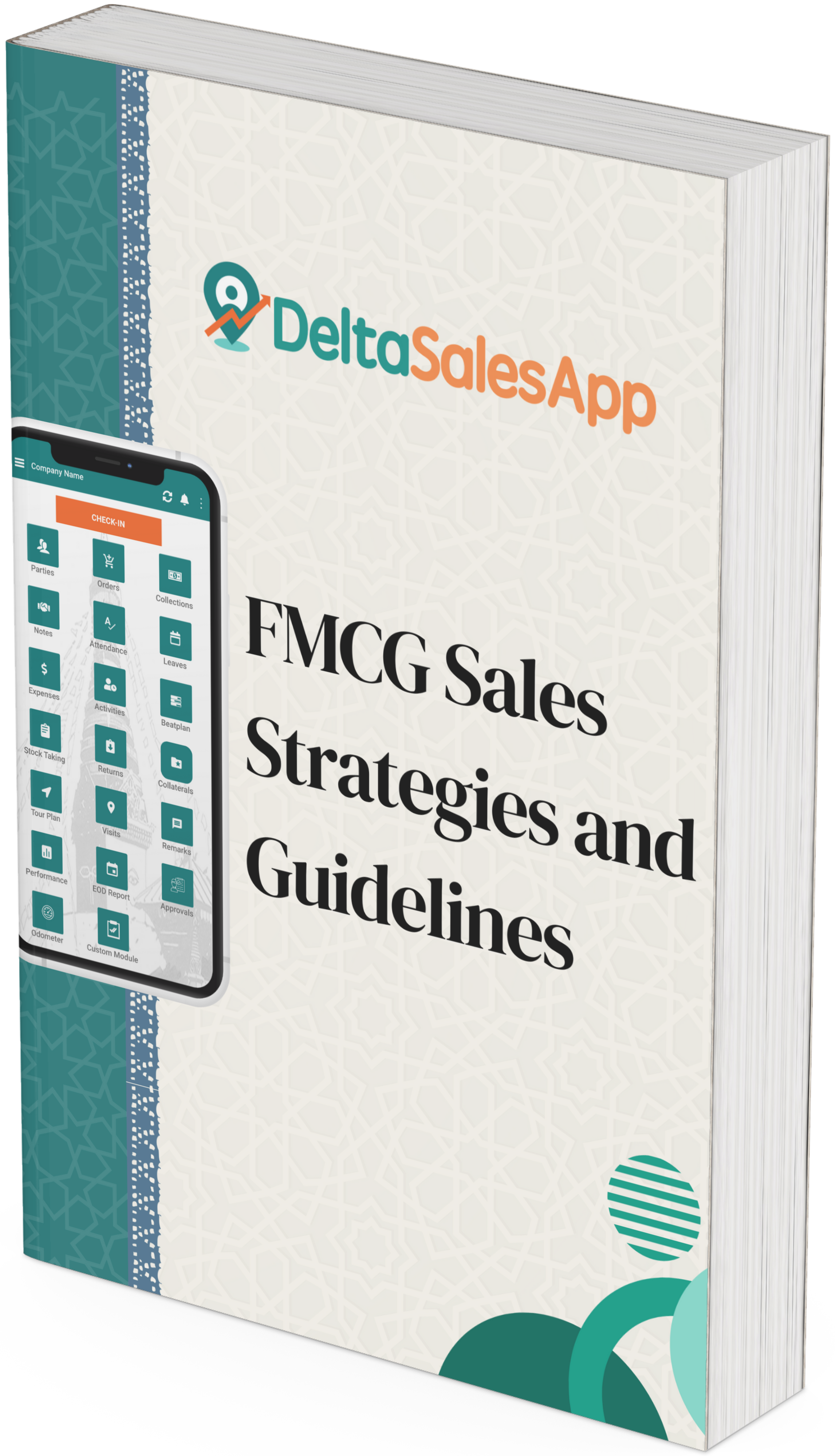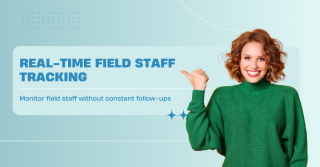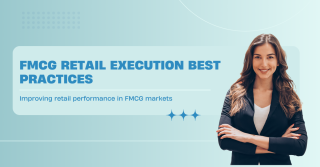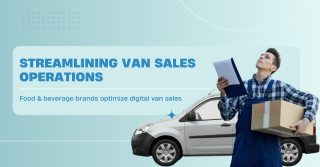The Ultimate Guide to Beat Planning for FMCG Brands

In the dynamic world of Fast-Moving Consumer Goods (FMCG), efficiency in field operations is not just desirable—it’s essential. Managing visits manually is no longer feasible with hundreds, sometimes thousands, of retailers, dealers, and distribution points. That’s where beat planning becomes a cornerstone of operational success.
Without a structured plan, field sales representatives may be left guessing which stores to visit, resulting in missed opportunities, inefficient territory coverage, and unhappy retailers. This guide dives deep into what beat planning is, why it matters, how to design a high-performing plan, and how cutting-edge software can take your beat strategy to the next level.
What is a Beat Plan?
A beat plan is a structured and strategic schedule that outlines which retail outlets a field sales representative should visit, in what sequence, and how frequently. It is customized based on store type, business potential, urgency of service, and historical data such as past orders, visit recency, and unresolved issues.
Think of it as a daily or weekly roadmap, guiding sales reps through the chaos of retail territory to foster meaningful B2B interactions with dealers, wholesalers, and shop owners.
Key objectives of beat planning:
Build strong relationships through regular, purposeful visits
Ensure no store faces stockouts or poor servicing
Maximize sales opportunities through timely order collection and issue resolution
Without a solid beat plan, reps may either over-service some stores while completely missing others, or simply exhaust themselves covering unnecessary ground.
Why Beat Planning is Crucial in FMCG Sales?
FMCG businesses thrive on volume, frequency, and consistency. These elements are only possible with a data-driven route plan that aligns manpower with business needs.
Here’s what poor beat planning leads to:
Missed high-value orders
Low retail satisfaction due to delayed issue resolutions
High travel time with reduced productivity
Poor visibility into sales rep activity
Resource misallocation
In contrast, intelligent beat planning ensures high-priority stores are visited when needed, improving both sales numbers and retail satisfaction.
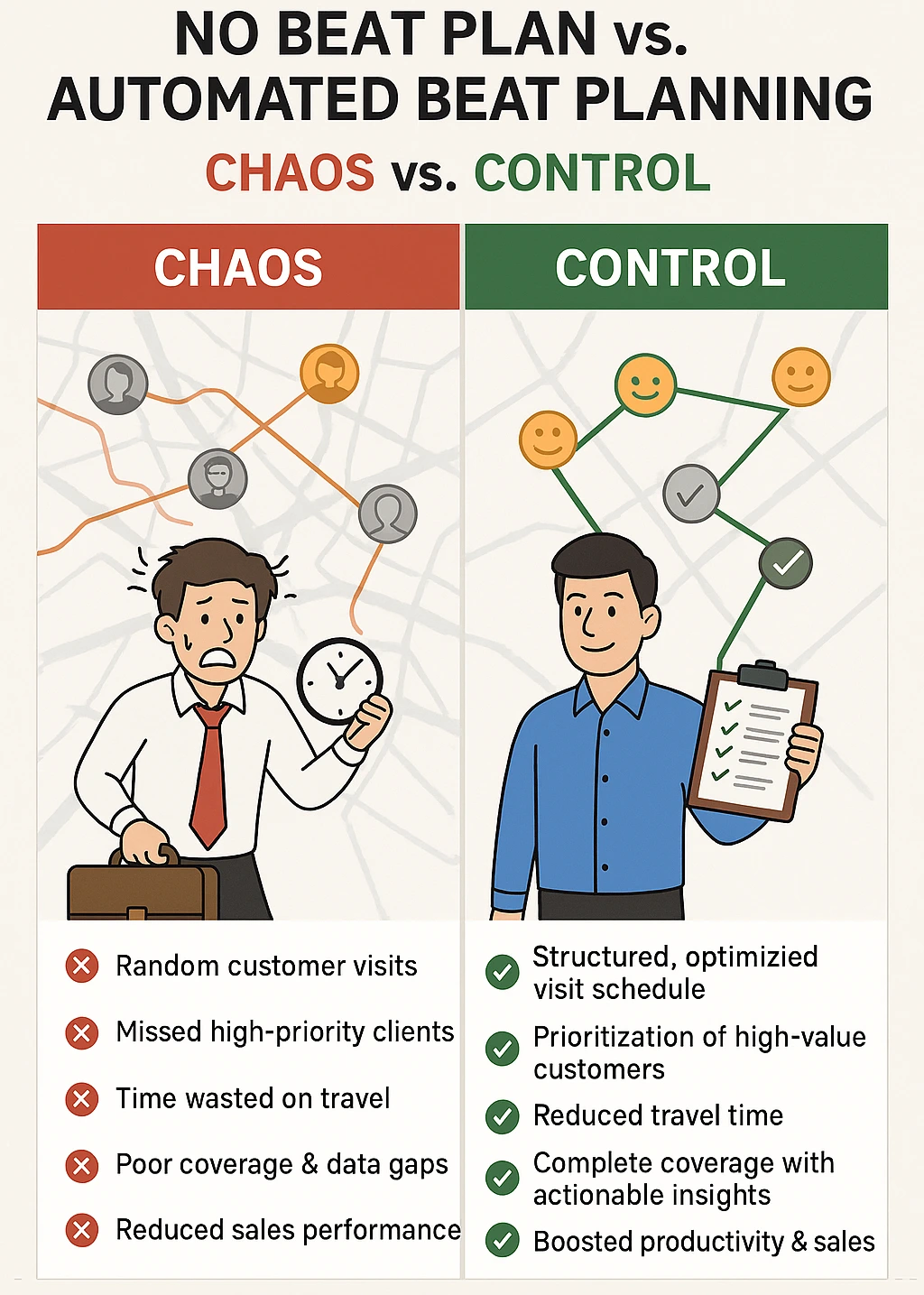
Benefits of an Effective Beat Plan
Let’s explore what a robust beat plan can do for your FMCG business:
1. Boosts Sales Productivity
An optimized beat plan assigns territories to sales reps based on experience, region familiarity, and historical performance. This fosters better communication, trust-building, and ultimately more productive store visits.
2. Increases Order Volume
More effective visits = more face time = more orders. When reps can focus on engagement rather than logistics, they build retailer trust and close more deals. A tailored beat plan allows reps to upsell, cross-sell, and pitch new products more frequently.
3. Improves Territory Management
Strategically dividing territories avoids overlap and under-servicing. Assignments consider:
Store size and importance
Geographic proximity
Store performance metrics
Rep experience and past performance
This minimizes travel time and maximizes in-field effectiveness.
4. Enables Smarter Resource Allocation
By using intelligent planning algorithms, field teams visit stores that need them now, not on arbitrary schedules. For example:
A store with no order in 3 weeks
A dealer with unpaid invoices
A retailer with consistent complaints
These become priority visits, ensuring proactive service.
🗺️Creating the Ultimate Beat Plan: A Step-by-Step Guide
Designing a great beat plan isn't just about plugging in locations into a map. It's a strategic process that blends business intelligence with sales goals. Here’s how to build one:
Step 1: Define Your Objectives
Start by aligning beat planning with business goals:
Increase sales in low-performing territories
Launch a new product line
Improve service consistency
Boost coverage in new regions
Step 2: Segment Your Market
Use store data to segment your market by:
Location
Purchase power
Order frequency
Payment reliability
Each segment gets a specific visit frequency and priority score.
Step 3: Allocate Territories
Assign each rep a set of stores using workload balancing, ensuring:
Equal effort distribution
Geographical efficiency
Account priority handling
Step 4: Set KPIs
Establish clear performance metrics:
Visits per day/week
Orders per visit
Issue resolution time
Time spent per store
Sales-to-target ratio
These allow ongoing plan refinement.
Step 5: Train Your Team
Equip reps with training in:
Using digital tools for beat tracking
Product knowledge and negotiation
Handling complaints professionally
Step 6: Monitor & Improve
Collect data continuously and adjust your beat plan based on:
Sales trends
Product uptake
Retailer satisfaction
Market shifts
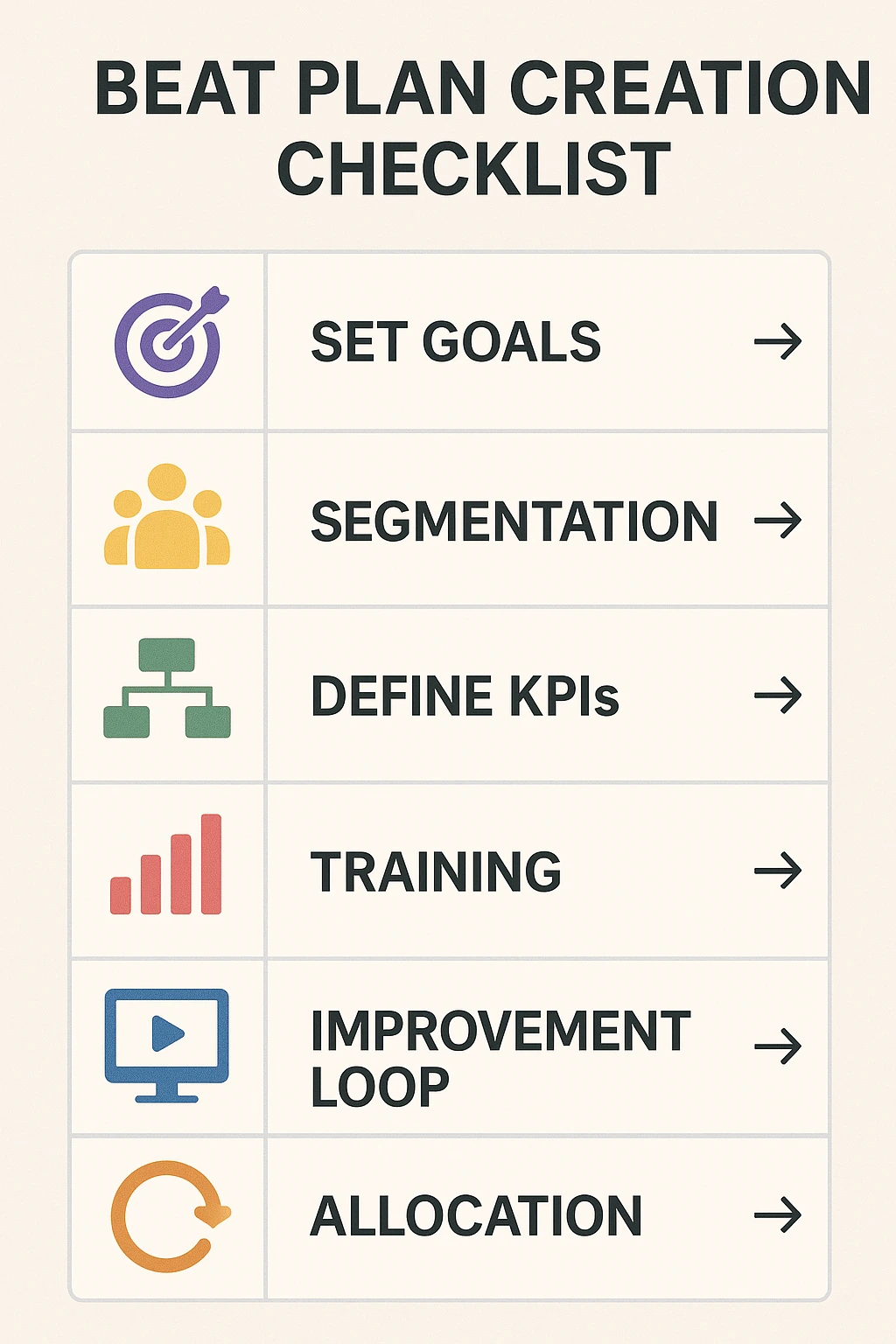
Smart Field Visit Planning Tools: The Backbone of Modern FMCG Field Execution
Manual scheduling and paper-based routes can't keep up with today’s fast-paced FMCG environment. Smart field visit planning tools use real-time data, AI-driven insights, and dynamic routing to empower sales teams with optimized daily schedules. These tools help prioritize visits based on store performance, order history, and unresolved issues, ensuring reps focus where it matters most. The result? Higher productivity, reduced travel time, and improved retailer satisfaction all at scale.
Leveraging Next-Gen Software to Supercharge Beat Planning
Manual beat planning works, but only up to a point. That’s where an intelligent field sales app steps in to scale operations. For scalable growth and consistent performance, automated and AI-driven planning tools are critical.
The latest tools allow FMCG brands to build dynamic beat plans that adapt to real-world conditions and sales data. Some of the key features include:
🔍 Intelligent Store Prioritization
Sales volume history
Time since last visit
Last order value and date
Open complaints or tickets
Pending invoices
Campaign participation
Each store gets a priority score that updates automatically, ensuring the rep’s day is spent where it counts most.
📍 Route Optimization
Advanced mapping features reduce travel time and suggest real-time reroutes based on:
Traffic
Distance
Order urgency
Retailer availability
📈 Integrated Sales Data & Forecasting
Combine beat planning with:
Sales forecasting tools
Inventory planning
This leads to better future planning and more predictable revenue growth.
👥 Customizable Reassignment & Flexibility
Managers can reassign reps to new stores or update beats instantly, especially during product launches, campaign rollouts, or market fluctuations.
Real-World Impact: What Happens with Smart Beat Planning?
Here’s how advanced beat planning tools make a real difference in FMCG:
🚀 35 %+ increase in productive store visits per rep
📦 25% increase in order volume in high-potential outlets
🕒 Up to 40% reduction in travel time across territories
🧾 Better resolution of open issues (fewer pending tickets)
📊 Improved forecasting due to more consistent ordering
And most importantly, Retailer satisfaction scores go up due to consistent, professional, and attentive service.
Summing Up
Beat planning is no longer optional, it is the backbone of successful field sales in FMCG. With high competition, ever-changing markets, and evolving customer expectations, brands need to bring their A-game when it comes to retail engagement.
Leveraging intelligent beat planning powered by automation and data analytics gives your sales teams the power to:
Prioritize key accounts
Reduce wasted effort
Build better customer relationships
Improve sales output
As this technology continues to evolve, the brands that adopt early and optimize consistently will see the biggest wins.
📊 Before vs After: Impact of Automated Beat Planning
🔄 Side-by-Side Metrics Comparison
Metric | Before (Manual Planning) | After (Automated Beat Planning) |
Visits per Day | 8–10 | 14–16 (+60%) |
Avg. Order Value | $220 | $300 (+36%) |
Time Efficiency | 65% productive hours | 90% productive hours (+25%) |
Complaint Resolution | 72 hours avg. | 24 hours avg. (−67%) |
❓ Frequently Asked Questions (FAQs)
1. What is the main purpose of beat planning in FMCG sales?
Beat planning helps sales teams visit the right outlets at the right time, ensuring effective coverage, improved order collection, better retailer engagement, and minimal travel time.
2. How does a sales route management tool help in beat planning?
A sales route management tool uses intelligent algorithms and real-time data to create optimized daily routes for field reps. It prioritizes visits based on factors like store potential, past orders, and open issues.
3. Can I track my field sales reps in real time using beat planning software?
Yes. Most modern field sales tracking apps come with GPS-based tracking, allowing managers to monitor field movements, ensure compliance with plans, and improve accountability.
4. Is automated beat planning suitable for small FMCG businesses?
Absolutely. Automated beat planning helps small businesses maximize limited resources, reduce sales rep idle time, and increase order volumes by focusing on high-potential stores.
5. What makes Delta Sales App a good choice for beat and route planning?
Delta Sales App combines beat planning, sales team tracking, sales order management, and territory management into one powerful platform. It helps FMCG brands streamline their field execution with automation, data-driven insights, and easy-to-use mobile tools.
Explore more
👉Beat and Route Plan in FMCG Sales
👉How to Select the Best Sales Software for Your Growing FMCG Brand: The Ultimate Guide
See What Users Say About Us!
Delta Sales App, trusted by businesses for streamlining sales processes and boosting productivity, is highly rated on top review platforms.
See what real users have to say about us:
⭐ Delta Sales App on FirmSuggest
Schedule a demo today to see how smart beat planning software can transform your brand’s field execution.
